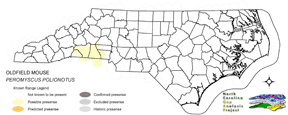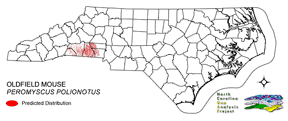
| Taxa: |
| Order: |
| Family: |
| Mammalia |
| Rodentia |
| Muridae |
| NatureServe Global Rank: |
| NatureServe State (NC) Rank: |
| G5 |
| S1 |
| Federal Status: |
| NC State Status: |
| --- |
| SR |


| Land Unit |
| US Fish & Wildlife Service |
| US Forest Service |
| US National Park Service |
| US Department of Defense |
| NC State Parks |
| NC University System |
| NC Wildlife Res. Com. |
| NC Forest Service |
| NC Div. of Coastal Mgmt. |
| Local Governments |
| Non-Governmental Org. |
| Other Public Lands |
| Private Lands |
| GAP Status 1-2 |
| All Protected Lands |
| Statewide |
| Hectares |
| 3.42 |
| 0.00 |
| 0.00 |
| 0.00 |
| 21.87 |
| 0.00 |
| 28.53 |
| 0.00 |
| 0.00 |
| 0.72 |
| 13.23 |
| 0.00 |
| 106,539.48 |
| 54.54 |
| 54.54 |
| 106,607.25 |
| Acres |
| 8.45 |
| 0.00 |
| 0.00 |
| 0.00 |
| 54.04 |
| 0.00 |
| 70.50 |
| 0.00 |
| 0.00 |
| 1.78 |
| 32.69 |
| 0.00 |
| 263,264.74 |
| 134.77 |
| 134.77 |
| 263,432.20 |
| % of Dist. on |
| Prot. Lands |
| 6.3 % |
| 0.0 % |
| 0.0 % |
| 0.0 % |
| 40.1 % |
| 0.0 % |
| 52.3 % |
| 0.0 % |
| 0.0 % |
| 0.0 % |
| 0.0 % |
| 0.0 % |
| 0.0 % |
| 100.0 % |
| ----- |
| ----- |
| % of Dist. on |
| All Lands |
| < 0.1 % |
| 0.0 % |
| 0.0 % |
| 0.0 % |
| < 0.1 % |
| 0.0 % |
| < 0.1 % |
| 0.0 % |
| 0.0 % |
| < 0.1 % |
| < 0.1 % |
| 0.0 % |
| 99.9 % |
| < 0.1 % |
| ----- |
| ----- |
|
This species is relatively common in much of the piedmont and coastal plain of South Carolina, Georgia and Alabama, but is known only by a single record from Rutherford County to occur in North Carolina (Webster et al. 1985). Fallow and old fields with grass and forb vegetation are this mouse's primary habitat (Brown 1997). It also occupies coastal beaches, road sides, edges of cultivated corn, cotton, melon and peanut fields, and will occasionally use hedgerows or open forest stands (Webster et al. 1985, Whitaker and Hamilton 1998). Well to excessively drained sandy soils, which produce a moderately dense cover of vegetation with pockets of bare earth, are apparently preferred over mesic, densely vegetated sites (Brown 1997). NATURE SERVE GLOBAL HABITAT COMMENTS: Favors dry sandy fields and beaches with grass/shrub cover; at Merritt Island, Florida, usually among clumps of palmetto and sea grape with expanses of open sand or among dense palmetto-sea grape-wax myrtle. Occupies underground burrows when inactive; entrances in clumps of grass or beneath sheltering vegetation (Matthews and Moseley 1990). Young are born in underground burrows. |
| Code | Name | Description | NC Natural Heritage Program Equivalent |
| 180 | Agricultural Crop Fields | Farm fields used for row crops. | No equivalent |
| 205 | Agricultural Pasture/Hay and Natural Herbaceous | Farm fields used for pasture grass or hay production, as well as old fields dominated by native and exotic grasses. | No equivalent |
| 202 | Residential Urban | Includes vegetation interspersed in residential areas. Includes lawns, mixed species woodlots, and horticultural shrubs. Vegetation accounts for between 20 - 70% of the cover. | No equivalent |
|
Jones, J. K., Jr., et al. 1992. Revised checklist of North American mammals north of Mexico, 1991. Occas. Pap. Mus., Texas Tech Univ. (146):1-23. Wilson, D. E., and D. M. Reeder (editors). 1993. Mammal Species of the World:a Taxonomic and Geographic Reference. Second Edition. Smithsonian Institution Press, Washington, DC. xviii + 1206 pp. U.S. Fish and Wildlife Service. 5 July 1988. Proposed endangered status for the Anastasia Island beach mouse and threatened status for the southeastern beach mouse. Federal Register 53:25185-25190. Brown, L. N. 1997. A guide to the mammals of the southeastern United States. University of Tennessee Press, Knoxville. xiv + 236 pp. Whitaker, J.O. Jr. and W.J. Hamilton, Jr. 1998. Mammals of the eastern United States. Cornell Univ. Press, Ithaca, New York. 583 pp. Blair, W.F. 1951. Population structure, social behavior and environmental relation in a natural population of the beach mouse (Peromyscus poliontus leucocephalus) Contrib. Lab. Vertebr. Biol. Univ. MI 48. 47 pp. Carleton, M. D. 1989. Systematics and evolution. Pages 7-141 in G. L. Kirkland, Jr., and J. N. Layne, eds. Advances in the study of PEROMYSCUS (Rodentia). Texas Tech Univ. Press, Lubbock. Fleming, K., and N. R. Holler. 1989. Endangered beach mice repopulate Florida beaches. Endangered Species Tech. Bull. 14(1-2):9, 11. Bowen, W. W. 1968. Variation and evolution of Gulf Coast populations of beach mice, PEROMYSCUS POLIONOTUS. Bull. Florida State Mus. 12:1-91. King, J. A. (ed.). 1968. Biology of PEROMYSCUS (Rodentia). Am. Soc. Mamm. Spec. Publ. No. 2. 593 pp. Burt, W. H., and R. P. Grossenheider. 1976. A field guide to the mammals. Third edition. Houghton Mifflin Co., Boston. 289 pp. Hamilton, William J., Jr., and John O. Whitaker, Jr. 1979. Mammals of the eastern United States. Cornell Univ. Press, Ithaca, New York. 346 pp. Whitaker, J. O., Jr. 1980. The Audubon Society field guide to North American mammals. Alfred A. Knopf, New York. 745 pp. Webster, W. D., J. F. Parnell and W. C. Biggs Jr. 1985. Mammals of the Carolinas, Virginia, and Maryland. The University of North Carolina Press, Chapel Hill, NC. Extine, D. D., and I. J. Stout. 1987. Dispersion and habitat occupancy of the beach mouse, PEROMYSCUS POLIONOTUS NIVEIVENTRIS. J. Mamm. 68:297-304. Kirkland, G. L., Jr., and J. N. Layne. 1989. Advances in the study of PEROMYSCUS (Rodentia). Texas Tech Univ. Press, Lubbock. U.S. Fish and Wildlife Service (USFWS). 1990. Endangered and threatened species recovery program:report to Congress. 406 pp. Matthews, J. R., and C. J. Moseley (editors). 1990. The Official World Wildlife Fund Guide to Endangered Species of North America. Volume 1. Plants, Mammals. xxiii + pp 1-560 + 33 pp. appendix + 6 pp. glossary + 16 pp. index. Volume 2. Birds, Reptiles, Amphibians. Selander, R. K., et al. 1971. Biochemical polymorphism and systematics in the genus PEROMYSCUS. I. Variation in the old-field mouse (PEROMYSCUS POLIONOTUS). Studies in Genetics VI, Univ. Texas Publ. 7103:49-90. |
For more information please contact them at:
NC-GAP Analysis Project
Dept. of Zoology, NCSU
Campus Box 7617
Raleigh, NC 27695-7617
(919) 513-2853
www.basic.ncsu.edu/ncgap